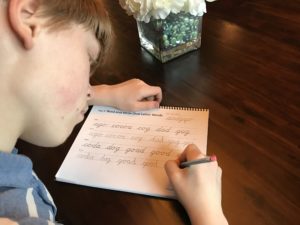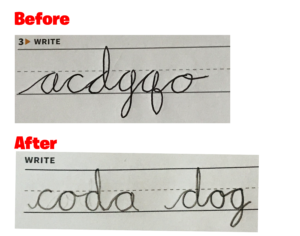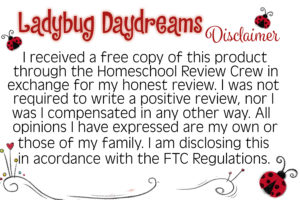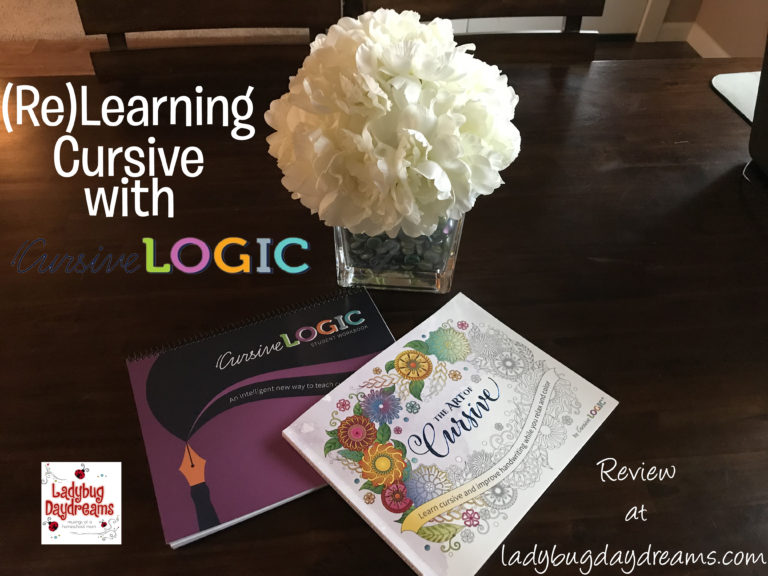A few weeks ago, the opportunity to review the CursiveLogic Quick Start Pack was presented to me. I might have passed, but then I got to thinking about Seahawk and how he sometimes forgets how to form his cursive letters. And when he doesn’t forget, they’re often sloppy – not difficult to read per se, just messy. So after some careful consideration, I decided he could probably benefit from CursiveLogic. In addition to the main curriculum workbook, we also received a copy of the The Art of Cursive coloring book. The other benefit of doing this review at this time was that it was right around the time we were displaced due to flooding, and having a physical workbook was something of a calming influence. It’s hard to explain, but it really helped us to feel grounded in a frantic time in our lives.
CursiveLogic is a bit of a different approach to writing in cursive. It doesn’t just teach the letters. Instead, this method breaks each letter down by shape, helping students to figure out the very basics of writing in cursive. Students learn at a young age to draw circles, but they’re never (usually) really taught how to use that basic skill to influence their handwriting. Thinking about it after having used CursiveLogic with my son (age 14) for a few weeks, and it really makes a lot of sense now, though. CursiveLogic has broken it down into four basic “starting” shapes, and every single letter in the English alphabet falls into one of those categories. The main one I’ll focus on today is the “orange oval,” which includes the letters A, C, D, G, Q, and O (in lowercase).
 Lessons are grouped by the color shape of the different letters, so your student won’t be learning the letters in alphabetical order. Each lesson has several parts and is divided up into “days.” Depending on your student and his or her maturity and motivation, you could potentially move quite quickly through the lessons. We chose to move a bit slower (as written, not too slow), but that’s because I really wanted to monitor my son and make sure he was mastering each shape as we moved. He’s a typical teenager and tends to a) be more concerned about finishing than doing well and b) easily revert back to old habits. I really wanted him to focus and get those shapes down as muscle memory before we moved on, so we didn’t move as fast as we might otherwise have with a student who already knows how to read, print, and write in cursive.
Lessons are grouped by the color shape of the different letters, so your student won’t be learning the letters in alphabetical order. Each lesson has several parts and is divided up into “days.” Depending on your student and his or her maturity and motivation, you could potentially move quite quickly through the lessons. We chose to move a bit slower (as written, not too slow), but that’s because I really wanted to monitor my son and make sure he was mastering each shape as we moved. He’s a typical teenager and tends to a) be more concerned about finishing than doing well and b) easily revert back to old habits. I really wanted him to focus and get those shapes down as muscle memory before we moved on, so we didn’t move as fast as we might otherwise have with a student who already knows how to read, print, and write in cursive.
 You can see in Seahawk’s “before” picture that his handwriting was adequate. Not amazing, not terrible, but adequate. After working on this lesson for just a few days, he showed great improvement. The thing that really helped him master it was when I explained to him that the oval shape has a bit of a hook on top before changing from the shape to the letter. Before this, he was getting more of a slide up into the letters rather than the oval shape. Once he understood the purpose of the oval, his handwriting improved immensely – and he said it was easier to write that way! It was quite rewarding to watch him “get it” and hear how much he appreciated these lessons. But it’s easier to appreciate something when you (the student) can see your own improvement, which was totally the case with Seahawk and CursiveLogic.
You can see in Seahawk’s “before” picture that his handwriting was adequate. Not amazing, not terrible, but adequate. After working on this lesson for just a few days, he showed great improvement. The thing that really helped him master it was when I explained to him that the oval shape has a bit of a hook on top before changing from the shape to the letter. Before this, he was getting more of a slide up into the letters rather than the oval shape. Once he understood the purpose of the oval, his handwriting improved immensely – and he said it was easier to write that way! It was quite rewarding to watch him “get it” and hear how much he appreciated these lessons. But it’s easier to appreciate something when you (the student) can see your own improvement, which was totally the case with Seahawk and CursiveLogic.
When he finishes the workbook, I think Seahawk will enjoy taking some colored pencils to the coloring book. We didn’t do a whole lot with it during the review period because I wanted him to focus on the actual work at hand (remember that teenager mentality – he could easily have tried to talk me into letting him color instead of doing a lesson, and that’s not adequate). In fact, The Art of Cursive is designed as a supplement to the curriculum, and is not intended to be something done instead of the lessons. He does seem quite interested in being able to work on the pictures that “are made up of cursive letters and words.” I think having that coloring book hanging out “mocking” him will be good motivation to him being willing to finish this curriculum.
In addition to the workbook and coloring book, CursiveLogic has a webinar. I wasn’t able to view it because we have iffy internet at the moment, what with being in temporary housing. Especially at the beginning of this review, I had no idea when we would be moving again. There are lots more Crew reviews, though, and several (maybe even most, I’m not sure) of them did watch the webinar, so make sure to click the banner below and check those out so you can learn more about that.
If you’re interested in trying CursiveLogic with your child (or yourself!), now is a great time to do it. CursiveLogic is offering a 20% discount on the CursiveLogic Quick Start Pack, which includes the workbook (not the coloring book) and webinar. These retail for $49 together. Just use coupon code CREW2018, which is good through March 31st, 2018.
Blessings,




